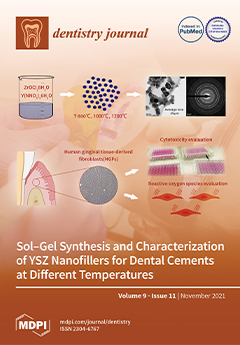GBR (guided bone regeneration) is a standard procedure for building up bony defects in the jaw. In this procedure, resorbable membranes made of bovine and porcine collagen are increasingly being used, which, in addition to many possible advantages, could have the potential disadvantage
[...] Read more.
GBR (guided bone regeneration) is a standard procedure for building up bony defects in the jaw. In this procedure, resorbable membranes made of bovine and porcine collagen are increasingly being used, which, in addition to many possible advantages, could have the potential disadvantage of a shorter barrier functionality, especially when augmenting large-volume defects. Thus, it is of importance to evaluate the integration behavior and especially the standing time of barrier membranes using specialized methods to predict its respective biocompatibility. This study is intended to establish a new histomorphometrical analysis method to quantify the integration rate of collagen-based barrier membranes. Three commercially available barrier membranes, i.e., non-crosslinked membranes (BioGide
® and Jason
® membrane), a ribose-crosslinked membrane (Ossix
® Plus), and a newly developed collagen–hyaluronic acid-based (Coll-HA) barrier membrane were implanted in the subcutaneous tissue of 48 6–8-week-old Wistar rats. The explants, after three timepoints (10, 30, and 60 days), were processed and prepared into histological sections for histopathological (host tissue response) and histomorphometrical (cellular invasion) analyses. 10 days after implantation, fragmentation was not evident in any of the study groups. The sections of the Coll-HA, Jason
® and BioGide
® membranes showed a similar mild inflammatory reaction within the surrounding tissue and an initial superficial cell immigration. Only in the Ossix
® Plus group very little inflammation and no cell invasion was detected. While the results of the three commercially available membranes remained intact in the further course of the study, only fragments of the Coll-HA membrane were found 30 and 60 days after implantation. Histomorphometrically, it can be described that although initially (at 10 days post-implantation) similar results were found in all study groups, after 30 days post-implantation the cellular penetration depth of the hyaluronic acid-collagen membrane was significantly increased with time (****
p < 0.0001). Similarly, the percentage of cellular invasion per membrane thickness was also significantly higher in the Coll-HA group at all timepoints, compared to the other membranes (****
p < 0.0001). Altogether, these results show that the histomorphometrical analysis of the cellular migration can act as an indicator of integration and duration of barrier functionality. Via this approach, it was possible to semi-quantify the different levels of cellular penetration of GBR membranes that were only qualitatively analyzed through histopathological approaches before. Additionally, the results of the histopathological and histomorphometrical analyses revealed that hyaluronic acid addition to collagen does not lead to a prolonged standing time, but an increased integration of a collagen-based biomaterial. Therefore, it can only partially be used in the dental field for indications that require fast resorbed membranes and a fast cell or tissue influx such as periodontal regeneration processes.
Full article






